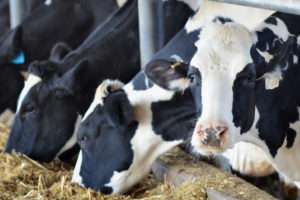 According to social media, Joaquin Phoenix’s Oscar acceptance speech has a lot of people asking whether it might be a good idea to ditch dairy. The answer is yes. In the name of compassion and justice, dropping dairy foods from your menus is a very good idea.
According to social media, Joaquin Phoenix’s Oscar acceptance speech has a lot of people asking whether it might be a good idea to ditch dairy. The answer is yes. In the name of compassion and justice, dropping dairy foods from your menus is a very good idea.
Farmers insist that dairy cows live happy, protected lives. They share photos and videos that certainly make it look like the cows on small farms are content. But every single one of those cows and every single one of their calves eventually goes to slaughter. Some are sick and weak when they are loaded onto trucks. They might travel through several livestock auctions before they reach the slaughterhouse. They may travel for long distances without food or water. And they are forced to stand for hours on end.
Even under the best of circumstances, cows prefer not to stand for long periods. And these are not the best of circumstances since a high percentage of cows who are sick or have joint problems and lameness are sent to slaughter. There is no question about the fact that they suffer in transport. It’s hard to square these facts with dairy farmers’ claims that their cows experience a good life and a humane death.
But as compelling as the reasons are for eliminating dairy foods, it can seem like a challenging dietary change. The challenge lies mainly in fears about nutrition, food preparation, and food enjoyment.
For anyone who has always relied on cow’s milk, yogurt and cheese for calcium, it’s sometimes surprising to learn that calcium is abundant in certain plant foods. Getting calcium from plants is different, but it’s not difficult.
A good rule of thumb is to eat at least three cups per day of some combination of plant foods that provide well-absorbed calcium. These include fortified plant milks of any kind, fortified fruit juice, edamame pasta, cooked cruciferous vegetables (kale, broccoli, collards, bok choy, turnip greens), and tofu made with calcium sulfate.
Replacing cow’s milk in recipes is just as easy. While it’s an ingredient that figures prominently in recipes for sauces, cream soups, and pancakes, any type of plant milk –soy, almond, pea protein, oat, or flax for example – works just as well.
And if you can’t imagine life without cheese, you most likely haven’t explored the excellent vegan cheeses on the market from innovative companies including Miyokos, Violife, Daiya, Follow Your Heart, and Tree Line. (This new generation of plant-based cheeses bears no resemblance to the vegan cheeses of the 1990s which admittedly were not great).
You can also make your own cheese, using ingredients that offer a good dose of umami. Although parmesan and other aged cheeses get all the umami credit, it’s a flavor/essence that was discovered in a plant – a sea vegetable, in fact. Other foods that are packed with umami include tomato paste, sundried tomatoes, nutritional yeast, miso, balsamic vinegar, dried mushrooms, and sauerkraut. Try blending soaked cashews with lemon juice, salt and a little bit of nutritional yeast for a spread that boasts all the umami and creaminess of cow’s milk cheese.
You’ll also find excellent vegan sour cream in stores (I buy mine at Stop and Shop) and all types of ice cream made from nuts, sunflower butter, coconut, and soy. Even Breyers makes vegan ice cream.
If you are moved by the plight of dairy cows but are still skeptical about a diet that doesn’t include dairy foods, take it one step at a time. Start by experimenting with different plant milks on cereal, in coffee, and in baking. Try some vegan cheeses and ice cream. Here is what you’ll most likely discover: You truly give up nothing when you go dairy-free.

Saying “were not great” is a huge understatement. Those 90s vegan cheeses were horrific. The new stuff is so good though, and there’s so many options now!
My favorites are Miyoko’s and Violife. Violife slices melt amazingly well for things like grilled cheese and have a great texture and flavor
Those of us who are in long back-and-forths on social media regarding the Joaquin Phoenix speech will greatly benefit from this concise and cogent blog-post. In fact, I’ll go post it around right now. Thanks for another great one, Ginny!
When relatives express worries about me getting calcium, I try to point out that calcium from supplements is as well absorbed as calcium from dairy,
https://pubmed.ncbi.nlm.nih.gov/3614304/